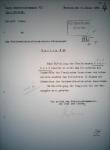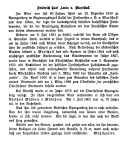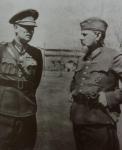-
Posts
4,908 -
Joined
-
Last visited
-
Days Won
97
Content Type
Profiles
Forums
Blogs
Gallery
Events
Store
Everything posted by Dave Danner
-

Finland Lt Paul Pollner Pilot in Finland 1918
Dave Danner replied to christerd's topic in Northern European & Baltic States
There was a Løjtnant P.B. Pollner in the 2den Artilleribataillon of the Fæstningsartilleriregiment in Copenhagen. He first shows up in the 1916 Statskalender in the list of the battalion's Løjtnanter af Forstœrkningen og Sekondløjtnanter, and is no longer there in 1918. Perhaps him? -
Here is one you can remove from the HOH3X list. Rohrbach, OLt. He is included In Geile's Hohenzollern list based on his entry in the Reichswehr rank lists. He was in the 1920s rank lists as a OLt. (1.4.25 (85)) in the 14. (Bad.) Inf.Rgt. with the HOH3X, EK1 and VAs. In World War I, he was a Lt. in IR 169. In Daniel's and Rick's Ernestine lists, there is an EH3bX for a Lt.d.R. Hellmuth Rohrbach in IR 169. Hellmuth Rohrbach was transferred from the reserve officers to the active officers of IR 169 on 6 March 1917. He is the officer in the Reichswehr 14.IR. The HOH3X was a mistake: Regards, Dave
-
Egon recieved the SEK3X on 15.1.15, also with Saxon RIR 244. His father Max Schneider was a professional officer. Egon was born on 24 November 1882 in Altenburg, where his father was a Premier-Lieutenant in IR 96 (then also an Altenburg regiment). Egon entered the army after graduating in 1903 from the Gymnasium Sondershausen, where his father was then the Landwehrbezirk-Kommandeur. Max Schneider retired in Sondershausen and received the SEK2 mit Eichenbruch on 28.7.16 while serving again as stellv. Bezirks-Kommandeur Sondershausen. Egon Schneider was an Oberleutnant in FAR 55 when the war began. He went to Luftschifftrupp 3 on mobliization, and for some reason ended up going to a Saxon regiment, RIR 244, in November 1914. He was only there a short time before being sent to observer training. He spent the rest of the war as an aviator. He was a Major (E) from 1935 to 1937. Came back as a Maj.z.D. in 1938, OTLzD on 1.1.42, released from active duty on 29.7.44. Other awards: EK2 (20.12.14), EK1 (15.9.18), Fliegerbeobachterabz. (25.1.18), Fliegererinnerungsabz. (8.1.20), Frontkämpferehrenkreuz (18.12.34), Ung. Kr.Erinn.Med. (7.7.36), Österr.Kr.Erinn.Med. (17.10.36), WLDA2 (2.10.36) Regards, Dave
-
He was an active-duty Wehrmacht officer for ten years, so I imagine he would have had more than enough opportunities to wear a Feldspange and at least a few to wear a große Ordensspange. So I suppose the issue for us is only partly whether he earned it, and more whether, as you note, he wore it. We may have to include him in our Lippe-Detmold lists with an asterisk, but we have to include him, since if we come across a Feldspange with that combination, he would have to be a candidate. Similar to General der Flieger Ludwig Wolff, who is not in the Schwarzburg rolls, but shows up with an SEK3X.
-
Ich bin nicht gut mit zusammengesetzten Zeitformen, insbesondere im Passiv. Ist das richtig? - "Nachdem die LDPD/CDU Fraktion dazu gezwungen worden war, einen SED-Kandidat als OBM zu befürworten, wurde Hach freigelassen." für "After the LDPD/CDU faction had been forced to support an SED candidate for mayor, Hach was released." mfG, Dave
-
Well, he did affirm on his sacred honor that he got it, so there's that. His Schwarzburgisches Ehrenkreuz is in the rolls (he was a native). By the way, this "nach pflichtmäßiger Meldung" notation below is extremely common, especially for E-Offiziere. Their application package to be recalled to military service usually included a Militär-Dienstbescheinigung or an Auzgug aus der Kriegsrangliste. However, these often did not include post-November 1918 awards. So sometimes the officer provided other documentation - copy of the Verleihungsurkunde, for example - but otherwise they just affirmed it. I've only come across one officer who underwent an Ehrenverfahren for falsely claiming WW1 awards (in that case, a gold wound badge).
-
Can anyone confirm the class of award for Johannes Lutze? His personnel file says he received the "Ehrenkr. IV.Kl. 1.Abt. m.S. d. Lipp.Hausordens" on 10. November 1918. This would appear to be the LDH4aX. But Lutze was a Lt. in IR 54, previously in RIR 267, when the award was made. As a Leutnant, wouldn't he have received more likely the LDH4bX? He previously received the Lippisches KVK on 4.3.18. Thanks, Dave
-
Hi, I have been going back over all my notes and also older threads regarding Schwarzburg decorations, such as this one. The medal bar is not Bielfeld's. Someone must have married the document to the medal group later. Regarding the document: Dr. phil. Ernst Peter Heinrich Harald Bielfeld, *14.6.1863 in Sprottau, † 15.9.1933 in Arnstadt; Geheimer Regierungsrat, Oberbürgermeister and Landtagspräsident in Arnstadt. • SEK2E on 30.7.15 • SEK1 on 24.11.18 He did not have the Oldenburg order or the Centenarmedaille, but he did have the Rote-Kreuz-Medaille 2.Klasse and the Schwarzburg-Sondershausen Regierungsjubiläumsmedaille. So not his medal bar. The medal bar belonged to: Georg Alfred Gottlieb v. Witzleben, *16.3.1870 in Angelroda, †19.11.1936 in Dornheim. • SEK2E on 9.3.18 as Maj.d.Gd.L. and Führer, Garde-Landsturm-Infanterie-Bataillon Nollendorf G/10. • previously an active officer, the DOA 1908/09 shows him with the OV3c and Cent. He was also an Ehrenritter of the Johanniterorden. Besides Georg's SEK2E, the brothers Witzleben auf Angelroda are well-represented on the SEK rolls. Friedrich-Karl received the SEK1X (and earlier the SEK2X). Job Wilhelm Friedrich received the SEK1E. Hermann received the SEK2X. Also, Friedrich Karl's son Job Ernst received the SEK3X. Georg's was from Sondershausen. The others were from Rudolstadt. Best regards, Dave
-
Following up on this: I have identified 8 more recipients of both the SMK and the SEK3X from Schwarzburg-Sondershausen. They were previously unidentified for various reasons - no first name, too common last name, typos in the SMK or SEK3X rolls, etc. They are: • Beetz, Dr. phil. Wilhelm; Lt.d.R., IR 71 • Bergmann, Dr. phil. Arno; Lt.d.R., IR 32 • Erbslöh, Otto Walter; OLt.d.R., Ord.Offz. 76.IB • Jung, Albrecht; Lt.d.R., IR 71 • Limburg, Heinrich, Hptm.d.R. d. Kraftfahr-Btl. • Müller, Dr. jur. Fritz; Hptm.d.R., Stab d. Insp. d. Kraftfahrtruppen • Reyß, Hermann; Hptm.d.R., 1.Ord.Offz., 103.ID • Wiehe, Johannes; OLt.d.R., IR 32 All of these can be ruled out due to age or other awards. Alexis Voelker can be ruled out too. He had the LD1 and no Centenary. So, unless there is another SMK/SEK3X awaiting identification, we are back to Wolf Wölfel. He was born on 10 July 1874 in Merseburg. BTW, Georg Krommes, the Zahlmeister to whom Wölfel presented a dagger, received the SEK4X on 11.8.17 while serving in 2. Ldst.IB Gera XI/25. So he probably transferred from the Halb-Btl. Sondershausen along with Wölfel. Best regards, Dave
-
Hi Gunnar, Many thanks! I had the OLt in FAR 55 with a first initial of "F", not "E". What was his full name? Please let me know any other information so I can include a short summary (such name, birthdate, career highlights).in the Schwarzburg summary. How did he end up in a Saxon reserve infantry regiment? Dave
-
Hi Mikko, No. It would not be Hammer. He was a Luftwaffe reserve officer. A single 4-year Wehrmacht Dienstauszeichnung for a World War I veteran usually means an Ergänzungs-Offizier. The straight eagle device on the ribbon was used by the Heer and Kriegsmarine. The Luftwaffe Dienstauszeichnung had a Luftwaffe eagle, with curved wings. As I understand it, the 3rd and 4th classes look the same, only the device is different - gold for the 3rd and silver for the 4th. Here is a ribbon bar with one 3rd Class and two 4th Classes, one with oakleaves, along with the Winter War and Continuation War Medals: Dave
-
Can anyone identify who exactly this is? Hptm. Egon Schneider received the Saxon Albrechtsorden, Ritterkreuz 1.Klasse mit Schwertern, on 27.8.15 as a K.P. Hptm. in Saxon RIR 244. Earlier, he also received the Schwarzburg-Rudolstadt Ehrenkreuz 3.Klasse mit Schwertern on 15.1.15, also as a Hptm, in RIR 244. Both the Saxon and Schwarzburg rolls say only Hauptmann, not d.R./d.L./a.D., etc., which would imply he was an active officer, but German state rolls are often bad about getting this right. Also, I am not sure why an active Prussian Hauptmann would be in a Saxon RIR. I think the only Hauptleute in January 1915 for whom I do not have a first name are one from IR 85 (Hptm. 22.4.14) and one from IR 28, k.b. LwB Andernach (Hptm. 8.11.14). Neither seems to have an obvious connection to Saxony or Schwarzburg-Rudolstadt. So perhaps an a.D. officer or officer of the Beurlaubtenstand. There are unfortunately a bunch of those. Ones for whom I don't have a first name include: Hptm.d.R. d. IR 88 Hptm.d.L.-Jäg, Höchst Hptm.d.L.-Inf., Liegnitz Hptm.d.L.a,D, (Marburg), LdstIB Marburg Hptm.d.L.a,D, (Wetzlar), LIR 81 Hptm.d.L.-Inf., I Dortmund, LIR 30 Hptm.d.L.-Inf., III Berlin, LIR 12 Hptm.d.R.a.D., GGR 1 Again, none with an apparent connection to Saxony or Schwarzburg-Rudolstadt. Can anyone connect an Egon to any of these active, retired or reserve/Landwehr officers? Any help would be greatly appreciated. EDIT TO ADD: A Hptm. Egon Schneider in Flieger-Ers.-Abt. 1 is in the Ernestine rolls with an EH3aX on 1.12.16. Maybe the same guy? Thanks, Dave
-
According to the Militär-Wochenblatt (1906, s. 3342), Lt.d.L.-Jäger 2. Aufg. Müller-Hillebrand from Landwehr-Bezirk Montjoie retired on 17.11.06. According to the Amtsblatt der Kgl. Regierung zu Cassel, Oberförster Müller-Hillebrand in Montjoie was transferred to the Oberförsterstelle Lautenhausen with effect from 1.8.07. If it is the same guy, he is shown in the Oberförsterstelle Oldendorf in the 1913 Handbuch über den preussischen Hof und Staat. He is still there in the 1918 Court and State, as Forstmeister in Hessisch Oldendorf, and with an EK2. Regards Dave .
-
One Badener who can be ruled out: Hanns-Walther Hammer, * 6.3.1892 in Heidelberg. Lt.z.S./OLt.z.S., Seeflieger. Received the EK1&2, BZ3bX, TH, FinnFK3. He was a Maj./OTL d.R.z.V. in the Luftwaffe, so no Wehrmacht DA, especially without a Luftwaffe eagle. No idea what else he might have gotten in World War II.
-
As I understand it, oakleaves, like the bow (Schleife) meant you had received a lower class of the same order. So the "normal" progression would be: RAO4 RAO3 mit der Schleife RAO2 mit Eichenlaub Bruststern mit Eichenlaub z. RAO2E RAO1E and higher grades Crowns were a special distinction within a class, rather than part of the normal progression. Swords too, for that matter, with swords on ring indicating possession of a lower class with swords. And Brillianten for higher classes. And the Johanniterkreuz device. And the RAO3 was especially complicated because there were also a bunch of different ribbon combinations, both for the ribbon itself and for the Schleife. Andreas's web site shows all the possible RAO3 combinations: http://www.medalnet.net/Rote_Adler_3.htm Regards, Dave
-
He was Austrian, though I don't know why when he had this ribbon bar made South German-style, he chose to place the Austrian decorations after not only the EK2, which would be correct post-Anschluss, but also after the Hessen General Honor Decoration for Bravery. The Hesse medal was awarded to Austrians in K.u.k. Oberösterreichisches Infanterie-Regiment "Ernst Ludwig Großherzog von Hessen und bei Rhein" Nr. 14". This is probably a "war decorations only" ribbon bar, as it does not include other awards you would expect, like the Karl Truppen-Kreuz or the various WW1 commemorative medals. Or, for that matter, the 1933 Erinnerungsmedaille für das österreichische IR Nr. 14, which, while an unofficial award of the former ruling house of Hesse-Darmstadt, I have seen listed in personnel files for former k.u.k. IR 14 officers who joined the Wehrmacht. It looks like the last ribbon is missing swords. So probably the Order of the Iron Crown, the Military Merit Cross 3rd Class, two silver Signum Laudis, and one bronze Signum Laudis. Regards, Dave
-
Christer: Körner, Dipl.-Landw. Gottfried * 28.10.1896 in Leipzig. He was a Lt. in the Kgl. Sächs. Karabinier-Regiment, commanded to the Finnish Army from April to December 1918. He was Ib on the staff of the 1.Finn.Div. and an instructor at the Finnish Fähnrich-Schule Frederikshamm. Besides his German decorations, he received the Cross of Liberty on 25.10.18 and the Independence War Medal (no date given). The entry in the Saxon Kriegsrangliste is "Fi.F.R2", which follows the Saxon style for a Ritterkreuz 2.Klasse of an order, so this would probably correspond to a Cross of Liberty 4th Class. However, I thought most Germans got a "bump", so even a Leutnant would get the 3rd Class. He was a Hilfsoffizier/Gehilfe beim Militär-Attaché in Helsingfors from 1.3.36 to 18.6.41, and then OKH Verbindungs-Offizier zum Armeeoberkommando 18 from 19.6.41 to 14.10.41. He was a Hauptmann (E), and was promoted to Major on 1.3.40 while in Finland. His August 1942 officer evaluation report lists his "Auszeichnungen des jetzigen Krieges" as the KVK2X and the Cross of Liberty 3rd Class with Swords. The KVK2X was awarded on 1.9.41, but no date is given for the Cross of Liberty. By the way, there was another Körner from the Karabinier-Regiment, Lt.d.R. Rudolf Körner, who also served in Finland. He was Deutscher Adjutant to Karelian Jäger-Rgt. zu Pferde Nr. 3. He received the Cross of Liberty 3rd Class and the Independence War Medal. The two Körners were at best cousins - Gottfried's father was a Geh.Reg.Rat in Leipzig and Rudolf was born in South Africa where his father was a businessman. Regards, Dave
-

Slovakia Slovakian Ribbon Bars Recently Acquired
Dave Danner replied to Arnim's topic in Central & Eastern European States
-
I looked, but I didn't find anything. I would guess that after he left Bavarian service in 1903, he didn't maintain much of a connection, since he did not have family there and he lived so far away. So when mobilization was announced, he was not compelled to go back to Bavaria, and instead probably reported voluntarily to the Meldeamt in Bremen and ended up in the IX.Armeekorps replacement pool. As a fifty-year old who had not been in the military for over 10 years, he probably wasn't in that much demand in 1914, though of course things would soon change. I do know that he was in the field in 1914, as in the Wikipedia commons are some sketches he did on the Somme that year. Edit to add: Looking at a map, it appears Aschaffenburg was probably the closest place for him to report for Landwehr duty. You could take a train from Bremen to Frankfurt, and then over to Aschaffenburg. I wonder if Aschaffenburg was a Meldeamt for other Bavarians living in northern and central Germany? Leipzig seems to have filled this function for Prussian residents in the Saxon Army, while many Prussian officers living in Saxony appear to have reported to Halle a.S.






